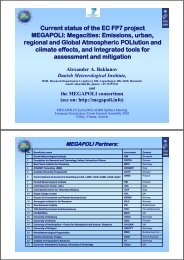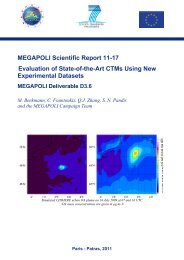D E S C R I P T I O N O F W O R K - MEGAPOLI - Dmi
D E S C R I P T I O N O F W O R K - MEGAPOLI - Dmi
D E S C R I P T I O N O F W O R K - MEGAPOLI - Dmi
You also want an ePaper? Increase the reach of your titles
YUMPU automatically turns print PDFs into web optimized ePapers that Google loves.
<strong>MEGAPOLI</strong> 212520<br />
WP8: Mitigation, policy options and impact assessment<br />
Work package number 8 Start date or starting event: 3<br />
Work package title Mitigation, policy options and impact assessment<br />
Activity Type RTD<br />
Participant number 2 3 4 6 14 15 16<br />
Person-months per part. 3 3 1.5 1.5 3 1 4<br />
Participant number 18 19 20 23<br />
Person-months per part. 1 19 1 1<br />
Objectives<br />
O8.1 Analysis and assessment of mitigation options and of policy options to efficiently reduce health and climate<br />
change impacts caused by releases of substances to the air in megacities<br />
O8.2 Development and application of a methodology and a tool for impact assessment<br />
Description of work and role of participants<br />
Task 8.1: Mitigation and policy options (lead: 19,14,2,15)<br />
The task will distinguish between short term options and measures, that can be implemented more or less until ca.<br />
2010 (e.g. traffic restrictions, city toll), medium term measures, that include changes of infrastructure and can thus<br />
be implemented in 2020 and long term options to be used after 2030 – time horizon until 2050.<br />
For the first two categories possible additional options and measures will be systematically collected, analyzed and<br />
assessed – additional means additional to those measures that are already used in the baseline scenario. For this<br />
purpose, existing evaluations of measures will be reviewed, such as the extensive set of recommendations by the<br />
INTEGAIRE network and forthcoming evaluations of plans and programmes reported by EU Member States under<br />
the AQ daughter directives. The assessment will include the estimation of potential/effect (emission reduction<br />
achieved) and the costs. As well technical measures (changing emissions factors e.g. by using filters) as nontechnical<br />
measures (that influence the behaviour resp. decisions) are covered. For non-technical measures, changes<br />
in utility have to be included in the costs. Other advantages and disadvantages will be qualitatively stated. The<br />
assessment will mainly be based on existing studies resp. analyses of measures.<br />
The measures are then ranked according to their estimated efficiency: as measures often change emissions of more<br />
than one pollutant and as a comparison across different impacts should be made, the estimation of the effectiveness<br />
(costs per t of pollutant reduced) is not sufficient; thus the reduced emissions are weighted with the marginal<br />
monetized avoided damages, results are the costs per € of damage avoided. Based on this efficiency criterion<br />
measures are then combined to bundles of measures or ‘strategies’.<br />
For these strategies, the changes in emissions (i.e. activities or emission factors) compared to the parameter values<br />
in the baseline scenario are estimated and reported to WP 1, where the emission tools are used to estimate the<br />
emissions, which are then delivered to WP 7 as input for the integrated assessment tools.<br />
Costs and difference in impacts compared to the base line scenario will then be used to assess the cost benefit ratio<br />
and the net present value of advantages of the strategies. Based on this, the options that policy has to initialize the<br />
realization of the strategies will be analyzed and assessed. From the result, policy recommendations will be<br />
developed.<br />
In addition long term mitigation and policy options (for 2030 to 2050) including structural changes, e.g. shift of<br />
industrial activities or living places to other areas are analysed; urban planning projects methodologies are used to<br />
develop scenarios of possible evolutions of megacities (Paris, London, Rhine-Ruhr, Po Valley, Mexico City), i.e. a<br />
qualitative description of the possible development of settlement structure and infrastructure and development of<br />
assumptions about the effect of these scenarios on transport, energy supply and emissions of air pollutants.<br />
Task 8.2: Interaction with megacities administration and other stakeholders (lead: 14, 19, 16, 4, 18, 2, 6)<br />
Aims: to inform stakeholders about the aims and intermediate results of the project, to discuss results, to collect<br />
available information.<br />
Contact has been established and will be maintained with the following stakeholders:<br />
The administrations of the megacities/agglomerations Paris, London, Rhine-Ruhr, Po Valley, Mexico-City; several<br />
DGs of the European Commission; and the EUROCITIES network.<br />
The contact is first established via individual visits of the contact partners, that are allocated to each stake holder<br />
(Paris: 6, London: 18, Po Valley: 4, Rhine-Ruhr: 19, Mexico-City: 2, EUROCITIES: 14, EC: 14/19). In these visits,<br />
the project is presented and information about emission data (together with WP1), about scenarios on the future<br />
development of the cities and their emissions, about analyses of the potential and costs of abatement measures,<br />
about experience with air pollution and GHG reduction strategies already implemented and planned and about plans<br />
about future abatement strategies and their effect is systematically collected. The information is translated,<br />
transformed into a given structure and provided to Task 8.1.<br />
48




